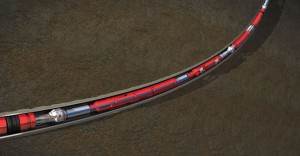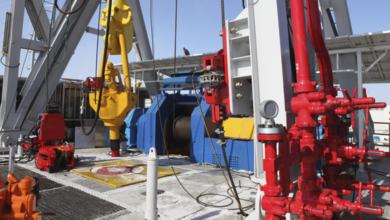D&C Tech Digest
Ultra-temperature ESP installed in SAGD wells
Baker Hughes has installed the world’s first ultra-temperature electrical submersible pumping (ESP) systems in steam-assisted gravity drainage (SAGD) wells in the Canadian oil sands. Nine Centrilift XP ESP production systems, which can operate at fluid temperatures up to 250°C (482°F), have been installed since 15 April 2010.
Calgary-based Cenovus Energy, currently field-testing the system at its Christina Lake, Alberta, thermal project, is among the first to deploy the new technology.
“We expect the more robust system to increase run life and minimize operational expenditures,” said Jason Abbate, a production engineer with Cenovus. “Because the ESP system is operated at higher temperatures than conventional systems, we can also expect higher oil production rates.” SAGD production specialists expect an increase in production with a larger steam chamber and less viscous oil at higher steaming temperatures.
The system was developed at the Baker Hughes center in Claremore, Okla., where engineers can test ESP equipment at temperatures up to 300°C (572°F).
Apache to use new high-pressure riser system for jackup drilling program in North Sea
Aquaterra Energy is set to produce a high-pressure marine riser system for Apache North Sea that the company says will be a “world first” in terms of connections and its operation. The 10,000-psi rated, full-bore drilling riser system, complete with H4-compatible subsea connector, will be used during Apache’s 2011 drilling program on the Bacchus field in the North Sea. Three subsea wells are planned to be drilled using the Rowan Gorilla VII jackup rig.
A 10,000-psi Merlin connector will be used on the project and is an advance from current full-bore risers, which rely on flanged connections at this pressure. This change to a weld-on premium connector brings 10,000-psi risers in line with other jackup riser systems.
MZST well treatment process licensed out
ExxonMobil has licensed its Multi-Zone Stimulation Technology (MZST) well treatment process to Calfrac Well Services and Canyon Technical Services, both of Calgary, Alberta, Canada. The MZST process can be used to rapidly and reliably stimulate multiple reservoir zones in a single operation, yielding improved well economics. It was developed by ExxonMobil Upstream Research Co.
The MZST process can be particularly beneficial for fracturing operations in tight gas, shale gas and coal bed methane wells that target multiple reservoir zones, thick reservoir sections, or long reservoir intervals where multiple stimulation treatments are required. It will enable Calfrac and Canyon to optimize their stimulation operations by combining the deployment of perforating and fracturing equipment simultaneously in the wellbore to enable single-trip, multi-zone stimulations.
The technology significantly increases the number of zones that can be fractured per day compared with conventional fracturing/stimulation operations.
Statoil joins group to develop in-well acoustic flow meter
Statoil has joined a collaborative project formed in October 2009 by a consortium of Chevron North Sea, Silixa, University College London and Weatherford International to develop a fiber optics-based in-well distributed acoustic flow meter based on Silixa’s iDAS technology.
The British government-funded Technology Strategy Board is investing more than £750,000 over three years toward the budget of £1.8 million. The project continues through 2012, with further field trials planned.
The development project encompasses field trial installations, the first of which were successfully completed with first-generation instrumentation on six Statoil offshore wells in April 2010. These six wells already contained Weatherford’s in-well optical sensing systems and comprised of two water injectors, one gas injector, two producers with gas lift valves, and one high-rate Gas Oil Ratio producer. The iDAS technology allows the user to listen to the acoustic field at every point along many kilometers of fiber-optics sensing cable.
 500 mark reached for deployment of SmartWell systems
500 mark reached for deployment of SmartWell systems
Halliburton has passed the milestone of deploying 500 SmartWell completion systems. WellDynamics, a Halliburton business line, has deployed SmartWell completions in more than 26 countries. The first SmartWell completion system was deployed in 1997.




